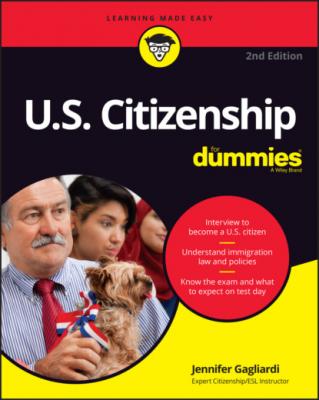ТОП просматриваемых книг сайта:
U.S. Citizenship For Dummies. Jennifer Gagliardi
Читать онлайн.Название U.S. Citizenship For Dummies
Год выпуска 0
isbn 9781119766896
Автор произведения Jennifer Gagliardi
Издательство John Wiley & Sons Limited
The U.S. immigration system works to achieve three main goals:
Bringing and keeping families together: U.S. immigration laws are designed to encourage families to stay together when possible. Immigrating through a family connection is the most common way people come to the United States.
Supplying a qualified workforce to keep the United States prosperin: Another of the USCIS’s duties is to help supplement the U.S. workforce by ensuring that there are enough foreign workers to fill positions not filled by U.S. workers.
Providing safe refuge and asylum: The USCIS also exists to help those who are seeking a safe refuge in the United States from political, religious, or social persecution in their home countries.
Identifying the Major Players and Their Roles in the Immigration System
A popular American expression with its origins in baseball, the country’s national pastime, says, “You can’t know the players without a score card.” And so it is with immigration. During the immigration and naturalization process, you’ll work with several government agencies. This section is your “score card” of the major players in the immigration game.
The Department of Homeland Security (DHS)
Effective January 24, 2003, the new Homeland Security Act represents the most significant and extensive transformation of the U.S. government in over 50 years. In the aftermath of the terrorist attacks against the United States on September 11, 2001, President George W. Bush decided 22 domestic agencies could better serve and protect the country if they were coordinated into one department. The new department reorganized a patchwork of government agencies under the authority of the Department of Homeland Security (DHS).
Counter terrorism and security threats
Secure U.S. borders and manage safe, orderly, and humane immigration processes
Secure cyberspace and critical infrastructure
Preserve and uphold the nation’s prosperity and economic security
Strengthen disaster preparedness and resilience
Champion the DHS workforce
One of the potential major advantages of the DHS is that it gives state and local officials one main contact instead of many when it comes to homeland-security needs. In theory, this will streamline the processes of efficiently obtaining necessary supplies and equipment, and training emergency personnel like police and firefighters, as well as medical personnel, to manage security emergencies. The DHS also manages federal grant programs, protects the U.S. borders, and more.
U.S. Citizenship and Immigration Services (USCIS)
Through the U.S. Citizenship and Immigration Services (USCIS), the DHS took over half of the INS’s former duties, including the following:
Adjudicating (hearing and deciding on) immigrant and nonimmigrant petitions
Adjusting the immigration status of immigrants already in the United States
Issuing work authorization and other permits
Naturalizing qualified applicants for U.S. citizenship
Processing asylum and refugee cases
Deterring, detecting, and addressing vulnerabilities to the legal immigration system
Promoting lawful immigrants’ assimilation into American society
A DAY IN THE LIFE OF USCIS
The following info comes directly from the USCIS. On an average day, the USCIS does the following:
Adjudicates more than 28,000 requests for various immigration benefits.
Processes 3,100 applications to sponsor relatives and future spouses.
Analyzes nearly 600 tips, leads, cases, and detections for potential fraud, public safety, and national security concerns.
Processes refugee applications around the world in support of the refugee admissions ceiling of 125,000 refugees for fiscal year 2022.
Grants asylum to 25 individuals already in the United States.
Screens 170 people for protection based on a credible fear of persecution or torture if they return home.
Serves 800 people at in-person appointments for document services and other urgent needs.
Fingerprints and photographs 12,000 people at 130 application support centers.
Approves applications and petitions to help unite five foreign-born orphans with the Americans who want to adopt them.
Grants lawful permanent residence to more than 2,000 people and issues nearly 5,400 green cards.
Welcomes 3,200 new citizens at naturalization ceremonies — that’s one every 27 seconds. Typically, about 35 of these new citizens are members of the U.S. armed forces.
Ensures the employment eligibility of 100,000 new hires in the United States.
Receives 50,000 phone calls to its toll-free phone line and more than 150,000 inquiries and service requests via online accounts and digital self-help tools.
Receives 986,000 visitor sessions to its website.
Conducts automated verifications on employment eligibility and immigration status for more than 136,000 cases in E-Verify and 66,000 cases in SAVE.
Conducts manual reviews of eligibility and immigration status for more than 1,300 cases in E-Verify and 4,500 cases in SAVE.
Resolves more than 650 phone calls and 200 emails related to E-Verify and SAVE inquiries.
Processes 700 Freedom of Information Act (FOIA)/Privacy Act (PA) requests.
U.S. Customs and Border Protection (CBP)
United States Customs and Border Protection (CBP) is one of the Department of Homeland Security’s largest and most complex components, with a priority mission of keeping terrorists and their weapons out of the United States. It also has a responsibility for securing and facilitating trade and travel while enforcing hundreds of U.S. regulations, including immigration and drug laws. Other duties include
Securing the U.S. border
Preventing aliens from entering the country unlawfully
Preventing terrorists and other criminal aliens from entering the United States
Conducting border and port-of-entry inspections
Answering questions about and helping find solutions to immigration concerns brought by the public, special-interest groups, and other government agencies, as well as the U.S. Congress

